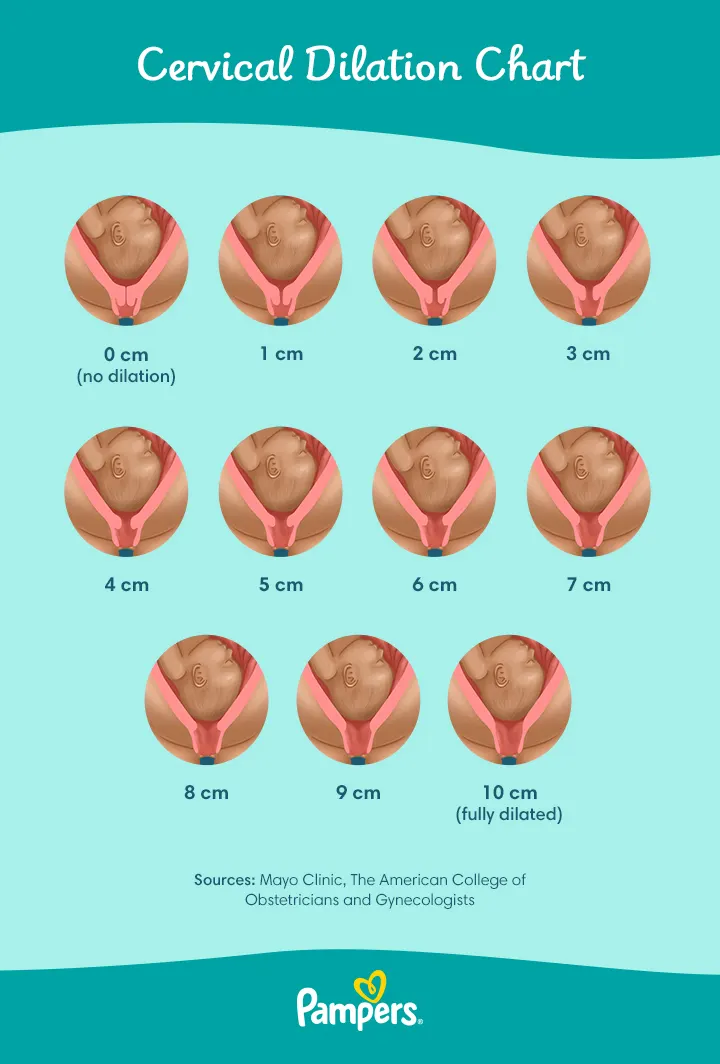Cervical Dilation in Labour: Stages, Symptoms, and More
One important part of labour and delivery is cervical dilation. But what exactly does “dilated” mean, and what happens during cervical dilation? We’re here to answer your questions about the process of your cervix dilating, the signs and symptoms, how to check as you progress, and how long till birth when you’re 1 cm dilated or 6, 7, 8, 9, 10 cm dilated. We’ll also let you know when it’s time to contact your healthcare provider. So, whether this is your first pregnancy or you’ve been pregnant before, read on for all the information you’ll need.
What Does “Dilated” Mean?
In the context of pregnancy, “dilation” or “dilated” refers to the opening of the cervix, a cylindrical, muscular organ at the lowermost part of the uterus that serves as a passage between the uterus and the vagina. During the course of pregnancy, the cervix remains closed (0 centimetres dilated), firm, and long, helping to keep your baby in the uterus until the right time for birth. So, if you want to know “What does 1 cm dilated mean?” it means that the opening of the cervix is currently 1 cm wide.
What Is Cervical Dilation?
When labour begins, contractions help the cervix to soften and shorten, known as effacement, and finally open or “dilate,” allowing for the baby to travel from the uterus, through the birth canal, and out into the world. Cervical dilation is measured in centimetres, and for labour to progress effectively, the cervix needs to dilate from 0 to 10 centimetres, with 10 centimetres being the approximate width of a baby's head. This preparatory stage is an important part of the labour process.
When Do You Start Dilating?
The initiation of cervical dilation varies from person to person and pregnancy to pregnancy. Some pregnant people may begin to dilate weeks before they go into labour, while others may only start dilation after labour has begun. Here are some general timelines to help you understand how cervical dilation may play out in the final weeks of pregnancy and in the various stages of labour:
Late pregnancy. Some pregnant people may begin to dilate slightly in the last few weeks of pregnancy. This is normal and is the body's way of gradually preparing for the birth.
Early labor. For many pregnant people, noticeable dilation begins during the early stages of labour. Regular contractions help the cervix dilate from 0 to 6 cm during this phase.
Active labor. This is where major dilation occurs, taking the cervix from 6 to 10 cm dilated.
Transition phase. This phase happens just before stage 2 when you’ll begin to push and finally deliver your baby. Before transitioning to stage 2, your healthcare provider will check that you’re 10 centimetres dilated and ready for your baby to pass through the birth canal.
Keep in mind that each pregnant person’s labour experience can differ. If you have any concerns about dilation or labour, speak with your healthcare provider.
How Long Does Cervical Dilation Take?
Whether you’re 2, 3, 4, 5, or 10 cm dilated, you'll be eager to know how much longer it will be until you give birth. Though the amount of time cervical dilation takes can vary greatly among pregnancies, several hours are usually needed for the cervix to dilate from 0 centimetres (closed) to 10 centimetres (fully open). However, this can take longer if it’s your first pregnancy and may be quicker for subsequent pregnancies. Here's a general idea of how long cervical dilation can take during each stage of labour:
In early labour, dilating from 0 to 6 cm can take from a few hours up to about 12 hours (though for some people, up to 20 hours).
During active labour, dilating from 6 to 10 cm generally takes around 4 to 8 hours. On average, you may dilate about 1 cm an hour.
Once you’re 10 cm dilated, how long till you give birth? When you’re at this stage, you’ll generally be ready to push and deliver your baby, which may take minutes up to a few hours.
How Dilated “Should” You Be at 37 or 39 Weeks?
It’s important to remember that cervical dilation may start a few weeks before labour begins. So, if your provider observes that you’re 1 cm dilated at 37 weeks or you’re not dilated at all by 39 or 40 weeks, that’s completely normal. Some pregnant people don’t start dilating until labour begins. We’re all different!
Signs You’re Dilating
So, can you feel your cervix dilating, what does it feel like, and does dilation hurt? As your cervix is dilating during early labour, you may or may not experience some signs and symptoms. It’s uncommon to detect physical symptoms of your cervix dilating; however, as labour begins, you’ll likely feel the uterine contractions that help dilation happen. Some other things you may notice as your cervix dilates are:
the loss of the mucus plug—a clear or bloody discharge from the vagina, also known as the “bloody show”
a sharp pain, twinge, pressure, or ache in the vagina and perineal area.
How to Check Cervix Dilation
How is the cervix checked for dilation? The most common method is a cervical exam performed by your healthcare provider. They will generally use their fingers (gloved) to measure the width of the opening. During your final month of pregnancy, your healthcare provider may perform regular pelvic exams to check your cervix and see if there are any changes or signs of dilation. Once labour begins, they will continue to check your cervix to see how much it is dilating. Again, dilation of 10 centimetres is usually what a healthcare provider is looking for in order to give the go-ahead to start pushing. Self-checking your cervix for dilation at home is not recommended. It’s always best to leave this up to your healthcare provider. So, if you suspect you’re in labour or labour is near, for example, you’re experiencing regular contractions or you’ve lost your mucus plug, contact your provider for a pelvic exam.
Cervical Dilation Chart
What does a dilated cervix look like? This is a common question during pregnancy, along with “What does 1 cm dilated look like?” and “What does 10 cm dilated look like?” Whether you want to visualize a dilated cervix at 1, 5, 7, 8, or 9 cm, or you’re wondering how big 10 cm dilated is, check out our chart below.
How to Help Dilate Cervix Naturally
While cervical dilation is a natural process that cannot be rushed, there are some ways to help the body along if you’re wondering how to dilate the cervix naturally. During early labour, it may help to stay as relaxed as you can and alternate rest with activity. Some things to consider include:
maintaining an upright position, such as by walking or squatting
staying hydrated
using relaxation techniques like deep breathing
listening to relaxing music.
Cervical Ripening
If your labour needs to be induced, your provider may need to ensure your cervix is soft and thin, which is called cervical ripening, so that it will start to dilate during labour. Some methods your provider may use to help your cervix dilate include:
medications containing prostaglandins. Prostaglandins are chemicals produced in the body with hormone-like actions. They can help to soften and relax the cervix during labour, therefore, medications containing prostaglandins are often used by healthcare professionals during labour induction.
inserting a thin tube with a balloon through the vagina into the cervix opening to inflate and dilate it
inserting slender rods called laminaria into the cervix. These rods expand when they absorb water.
Certain methods used to induce labour and start contractions may in turn help cervical dilation to progress. Among these methods are sweeping the amniotic membranes, administering oxytocin through an IV, and a procedure called an amniotomy (rupturing the amniotic sac).
When to Contact Your Healthcare Provider
It’s essential to stay in close communication with your healthcare provider throughout pregnancy and especially during the later stages. If you’re less than 37 weeks pregnant and experience any signs of preterm labour, such as menstrual-like cramps, pressure in the pelvic area or lower abdomen, or changes in your vaginal discharge, contact your healthcare provider immediately. They will likely do a pelvic exam to look for any cervical changes or dilation and monitor your contractions. If you’re 37 weeks or more, keep an eye out for signs of labour and contact your provider when you start experiencing any. They can tell you what the next step is and when you need to go to the hospital.
FAQS AT A GLANCE
Dilating from 1 to 10 centimetres varies among pregnant people, and even from one pregnancy to another. The longest period of dilation is generally during early labour when your cervix goes from 0 to 6 cm dilated.
The Bottom Line
Cervical dilation is a natural and necessary part of the labour and delivery process. By understanding the process of dilation, and the signs and symptoms, you can approach your birth experience with confidence. Remember to stay in touch with your healthcare provider and trust in your body's ability to progress at its own pace.
How We Wrote This Article The information in this article is based on expert advice found in trusted medical and government sources, such as the American Academy of Pediatrics and the American College of Obstetricians and Gynecologists. You can find a full list of sources used for this article below. The content on this page should not replace professional medical advice. Always consult medical professionals for full diagnosis and treatment.
Join a World of Support






